Recently a new Supermicro Hyper-Speed server was sent to STH for review. For those not familiar with Supermicro Hyper-Speed it is enterprise overclocking. Supermicro enables mild overclocks on their Hyper-Speed products. These overclocks are innovative in the data center because dual socket Intel Xeon E5-2600 series CPUs are multiplier locked. The company offers both workstation and 2U server variants of the platform. We were sent a SYS-6027AX-TRF for review, which is a 2U unit. This article will go over the chassis of the Supermicro Hyper-Speed SYS-6027AX-TRF which is the CSE-829BTQ-R1K28LPB.
Test Configuration
Supermicro sent the following test configuration for our testing. This represents one common configuration for a compute node. One other popular configuration is using dual Intel Xeon E5-2643CPUs (4C/8T) for applications where one needs high clock speed and lower core counts due to per-core license costs.
- Intel Xeon E5-2687W @ 3.224GHz base clocks
- SupermicroSYS-6027AX-TRF
- Supermicro X9DAX-iF Motherboard
- Samsung 8GB x 8 DDR3-1600 running at 1937MHz
Overall, this is the fastest dual socket configuration available in terms of today’s processors. Currently the Intel Xeon E5-2600 series line tops out with Intel Xeon E5-2687W at 3.1GHz base clocks and 8 cores / 16 threads each. As we will see, overclocking the CPU by 4% and memory by 21% yields the fastest configuration we can get at the moment.
Supermicro Hyper-Speed SYS-6027AX-TRF 2U Server Chassis
Part of the solution Supermicro provides is an integrated chassis plus motherboard. With the 2U solution, the system utilizes a Supermicro CSE-829BTQ-R1K28LPB chassis. Let’s take a look at what the Supermicro SYS-6027AX-TRF has to offer.
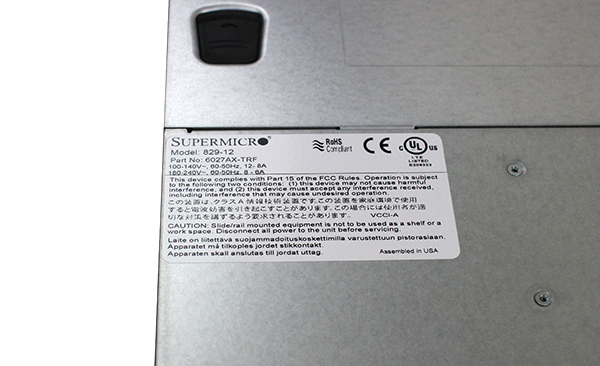
The front of the Supermicro CSE-829BTQ-R1K28LPB chassis has ten hot swap bays. The -TRF portion of the part number tells us that this is a SATA solution. One can see the standard ten hot swap bay front design. There is a spot for a slim optical drive if one requires it. One very interesting note is that the CSE-829BTQ-R1K28LPB has two USB 3.0 (SS USB) ports on the front panel. This is very unusual. The Supermicro SYS-6027AX-TRF also has Supermicro’s LCD status panel.
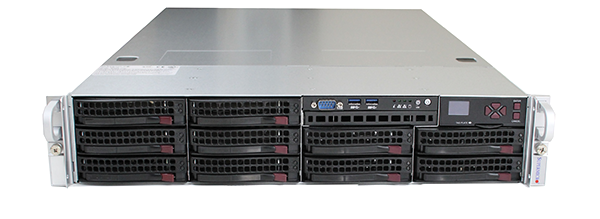
Moving to the rear of the chassis, we can see a few things. First, there are spots for 7 low profile expansion cards on the chassis. Second, there are more USB and USB 3.0 ports as well as audio output. The internal X9DAX-iF motherboard is used in both server and workstation form factors, so the server board does have some of these workstation features built in. We also see two Intel i350 Ethernet ports and a management NIC, standard fare on server motherboards. One will also note that the entire rear of the chassis is a massive vent to exhaust the fast moving air cooling overclocked CPUs.
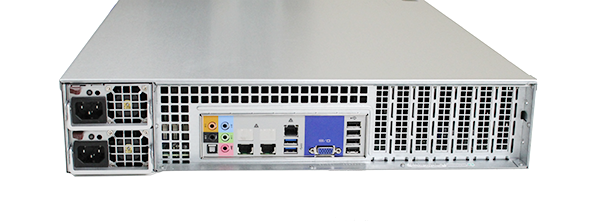
The power supplies are located in the rear of the chassis. Both redundant power supplies have tool-less hot swap capabilities. This is a standard Supermicro design and works well.
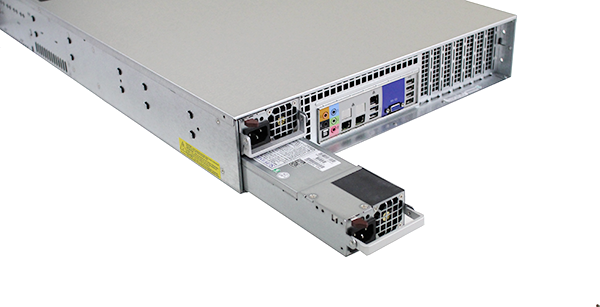
The PWS-1K28P-SQ power supplies are high quality power supplies. Each can deliver 1.28kW of power. They are rated as 80 Plus Platinum so one knows that these will run efficiently even if the chassis has both overclocked CPUs pegged at 100%, and all expansion capabilities maxed out. Each Intel Xeon E5-2687W is rated at 150w TDP with stock clocks so there is a lot of room for drives, fans and expansion slots. The four fans in the chassis alone can require up to almost 50w if they run at full speed.
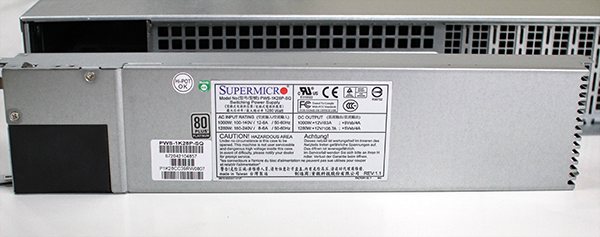
Opening the chassis required unscrewing four screws, two on either side. Inside, one can see that there is a large fan shroud that funnels air to the dual overclocked Intel Xeon E5-2687W processors, memory and expansion cards.
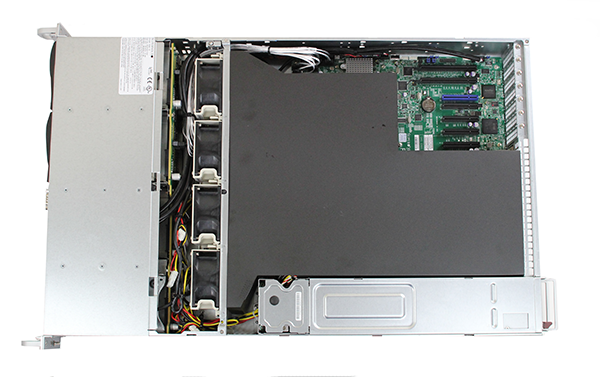
Cooling is provided by four large Nidec UltraFlow fans. Each 80mm fan is capable of 100CFM of airflow and can draw up to 16.8w. These large fans are needed to cool the Supermicro Hyper-Speed system and its overclocked processors and RAM.
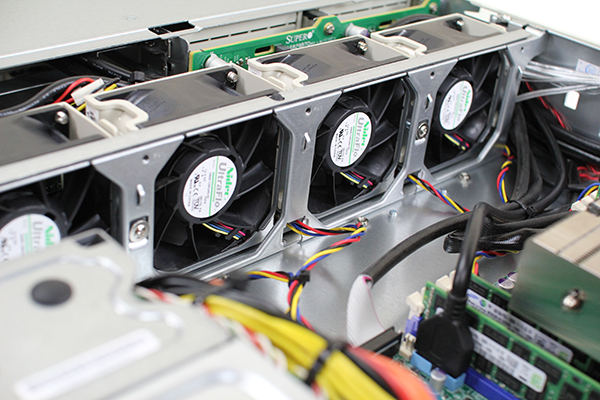
Sitting just in front of the Nidec fans is the hot swap backplane. The backplane takes 7-pin SATA inputs and has hole in order to facilitate airflow through the chassis. The Supermicro X9DAX-iF test motherboard that came in the system does not have SFF-8087 connectors. However, Supermicro does have versions with onboard LSI SAS controllers. For those systems, Supermicro also sells a SATA/ SAS backplane.
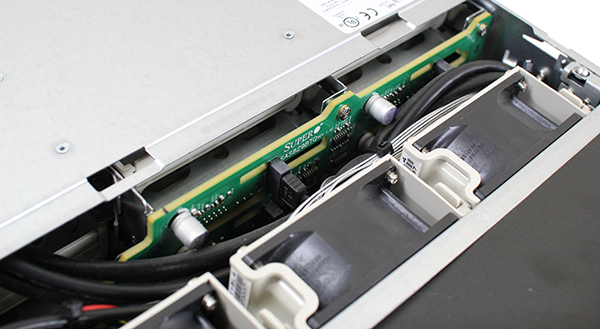
Closing Thoughts
As we go though the Supermicro Hyper-Speed server hardware, one will see the engineering that went into making the platform a stable performer even being overclocked in a data center. In future pieces we will explore the internal portion of the chassis with the CPUs, motherboard and memory in greater detail. We will also look at BIOS settings that are found on the Hyper-Speed products. Performance figures will follow, but suffice to say, this is probably the fastest production 2U dual-socket server around right now. Stay tuned!

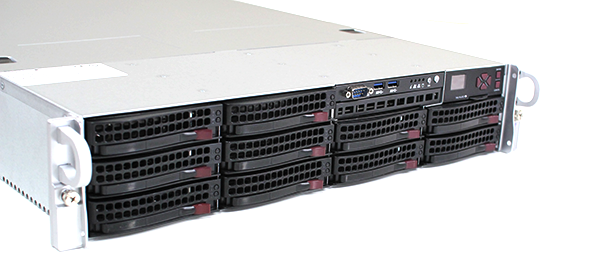



Great photos. Make something as boring as a server chassis look interesting.
Can’t wait to see what’s inside. We have been waiting for these.
Those PSUs are crazy. Not sure how you could get this to 1kW even adding Fusion-io cards. Then again, I guess you could keep a system in the sweet spot from an efficiency perspective.
Great job Supermicro!
Fail for no vibration reduced fans and only 10 bays.
A small digging around taobao get you:
RM2012-660-BX – 2U 12 bays chassis
Vibration reduced fans (has foamed/plastic where the fan is touching the chassis)
Fans with auto heat detection and speed adjust
That chassis is the best of all words and only cost you USD$250
Slap in a Zippy 1+1 2U PSU and X9DAX-iF and you get a better setup for USD$1000
Blah – Good luck with that knock off server.
1. It does not have a reliable 1.28kw PSU.
2. No optical disk bay.
3. Venting for the CPU heatsinks are meant for inline not offset CPUs like this motherboard.
4. It does not support motherboards this large.
5. No status LCD
6. Smaller fans at 60mm
7. Rails are an option. Supermicro sells servers with rails
8. Supermicro systems come with cables
The Zippy PSU alone will cost over $600USD – assuming you are using that- so by the time you ship that chassis and get it through customs in most countries, The total cost will be more than the SYS-6027AX-TRF.
Also, most companies want a single solution. Nobody wants to have the chassis vendor say its the power supply vendor’s fault and the PSU vendor says that it is the motherboard maker’s fault. Too many fingers to point and at best it would be the same price as just buying it all up front.
I’ve owned a number of Supermicro server chassis. In all of them, the fans are rubber mounted for vibration reduction.
Jose Salva is obviously a noob who doesn’t know how to shop.
1. It allow you to use your own, duh.
2. Who the f*ck still use CD/DVD in 2012 when everything is done over PXE/USB.
3. ROFL, the factory that makes the chassis provide different venting brackets for different motherboars. They’ll even provide solid metal blackpates for like USD$2 if you just give them the design.
4. Shrug, picking X9DAX-iF is a bad move the first place when you can pick X9DAi that is EATX. Plus there are countless similar chassis on taobao in half the price, now those chassis priced at $100 are knock offs, this one at $250 is already top shelf.
5. Who gives a shit, there are lcd version available but wtf cares about lcd.
6. ROFL, that’s why you can use 5 of them instead of 4 and get better cooling.
7. You can pick up any rails from the same store (or any other store) for USD$20.
8. They all come with cables, they also sell them for like $5 if you need spares.
The PSU is always up to the user to pick their own brands and price ranges, if you are in love with supermicro then buy the PSU from Supermicro. Most companies want cost effective products that work, everything else is bullshit.
Stop commenting on things you don’t understand let alone used, learn to appreciate people when they offer a better alternative. Geez you don’t even know how to ship cheaply. Have fun getting ripped off.
You idiots sounds like you are in bed with Supermicro when all chassis’ are just pieces of bent metal with some plastic and some simple circuit boards.
Poor Jose Salva doesn’t even know Supermicro have been using parts made in China for years. When you buy directly form the source you save $, end of story.
uh I don’t get it. This is a pre-configured system for high frequency trading. Why is Blah making inflammatory statements about just a case?
We have a cage of HFT servers. No way we would build our own. A few hundred dollars per server is not worth potential headaches or the time to assemble.
Blah to the board not fitting you suggest an alternative that does not overclock so you still are running a slower system. In our business, slower means you are on the wrong side of the trade.
I think most manufacturers build in China, but you are talking about a case that does not work for the application. Those of us looking at hyper-speed are not as price sensitive since having a slight edge in machine speed means much more in daily profits. Not sure why you would be down on someone pointing that out.
This is not meant to be a value platform. These are being colo’d in some of the highest cost datacenters around.
@Patrick can’t wait to see more of the review.
@Gregor
Nonsense, if you are not worried about money then you wouldn’t worry about overclocking, just pick the CPU with the highest clock speed or go for a totally custom cooling setup that overclocks to 4 or 5ghz.
Or if your app is threaded then you’d go for a cluster consists of 1U twins and pack as many CPU in as little space as possible and then move the disks to an external array.
If you’re looking for speed then you’ve already failed by picking anything similar to this setup.
Btw the edge on HFT is ultimately on network latency, not CPU, so another fail for you.